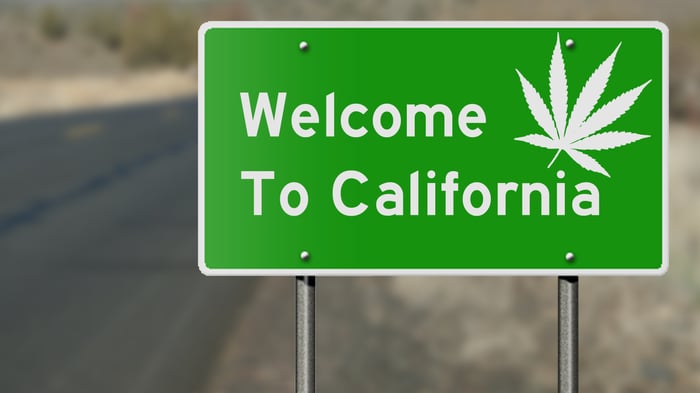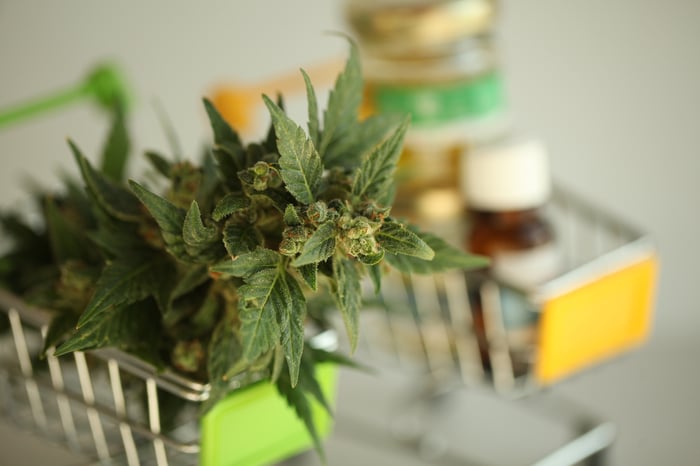In case you haven't noticed, marijuana is budding into a big-money business. Last year, the legal weed industry generated a whopping $10.9 billion in worldwide sales, and by the end of the next decade we could be talking about as much as $200 billion in annual revenue.
Though the entire world presents as an opportunity for the marijuana industry, it's the United States that's widely considered the crown jewel. Depending on your preferred source, the U.S. may wind up generating a third to perhaps more than half of all annual sales in a decade.

Image source: Getty Images.
Within the U.S., there are more than a dozen states expected to become billion-dollar marijuana markets within the next five years. But it's the Golden State, California, that's forecast to lead all states, and all markets, in total legal weed sales. By 2024, the duo of Arcview Market Research and BDS Analytics foresees $7.23 billion in annual legal cannabis spending in California. That's out of $30.1 billion in estimated legal spending in the entire United States that year.
To say that California is important to the long-term success of the marijuana industry would be an understatement. But, just the same, to say that California has failed on a monumental level to support its legal cannabis industry would also be a gross understatement.
To date, California's legal pot industry has been a major disappointment
On Jan. 1, 2018, California opened the door to legal recreational weed sales. This was the result of residents of the state voting decisively to approve Proposition 64 in Nov. 2016. When initial projections were released, the Golden State was expected to bring in $643 million in tax revenue in its first year of adult-use sales. But when the figures were tallied, California's Department of Tax and Fee Administration collected a meager $345.2 million in 2018. In fact, data from Arcview and BDS Analytics shows that legal spending actually declined in California in 2018, from $3 billion in 2017 (entirely in medical cannabis) to $2.5 billion.
How on Earth did things go so wrong for California's pot industry?

Image source: Getty Images.
One answer would be to look at the state's taxation of legal marijuana, which is the highest in the country. Marijuana users are collectively being asked to pay state tax, sales tax, an excise tax on weed, and a wholesale tax on either leaves or cannabis flower. This alone can add up to an aggregate tax of 45%. But that's still not all, as laboratory testing and other regulatory costs are built into marijuana pricing in the Golden State. This makes for gigantic disparities in per-gram pricing between the legal and black market, with illicit producers easily able to undercut legal-channel pricing.
Another pretty obvious problem is that, despite California as a whole legalizing adult-use pot, municipalities have the option of deciding whether or not to allow the retail sale of marijuana. Of California's 482 cities, a mere 89 (18.5%) are allowing retailers to open up shop. Mind you, California's largest cities are among those that have given the green light to legal recreational weed stores. But with so few cities throughout the state allowing for licensed dispensaries, it's opened the door for unlicensed business operators to thrive.
The black market in California is huge
We know that California's legal weed industry is struggling under the weight of persistent black market pressure. What we haven't been privy to is data or estimates that quantify this illicit presence... until now.
This past week, per the Los Angeles Times, the United Cannabis Business Association (UCBA) turned in the findings of an audit on illicit and legal operating cannabis stores to Gov. Gavin Newsom (D- Calif.) that was gathered with the aid of online website WeedMaps. The audit showed that there were 3,757 listings for a marijuana dispensary or cannabis delivery service in California... which is a problem given that only 873 cannabis sellers are licensed in the state. By the UCBA's estimates, 2,835 of the 3,757 listings on WeedMaps are for unlicensed sellers. Put another way, there are more than three times as many illegal retailers than there are legal dispensaries or delivery services.

Image source: Getty Images.
This is having a huge impact on aggregate sales within the state. According to estimates, legal weed sales are expected to total $3.1 billion in 2019, which compares to the $8.7 billion forecast for the black market. In other words, nearly $0.74 of every $1 being spent on marijuana in state is avoiding taxation since it's in the illicit market.
For its part, the State of California has announced that it would beef up the enforcement of black market producers and retailers. California's Bureau of Cannabis Control announced that it had served 19 search warrants at illicit dispensaries this year, and has seized more than $16 million worth of unregulated weed. Of course, $16 million is peanuts compared to the $8.7 billion in black market sales projected for 2019.
California-focused pot stocks may feel the pinch
Even though California remains the go-to market for marijuana stock investors, the persistent issues the state has had with the black market are likely to negatively impact the near-term operating results of California-focused dispensary operators.
As an example, MedMen Enterprises (MMNFF) has more than a dozen retail operations in California, which is one of the 12 states it has a presence in, on a pro forma basis. However, Wall Street's forward full-year loss estimate for MedMen has been widening pretty steadily for months. Aside from the fact that MedMen has been spending aggressively to move into new markets, the company's sequential sales growth from its established California locations hasn't been that impressive, at least considering the opportunity in the Golden State. Following 5% sequential growth in the third quarter, sales look to have risen by 10% during the fourth quarter in California retail stores. That's simply not good enough.

Image source: Getty Images.
Investors also have to wonder just how much of a benefit Cresco Labs (CRLBF 2.02%) will receive by purchasing Origin House (ORHOF). Origin House is one of a select few companies to hold a cannabis distribution license in California. By purchasing Origin House, Cresco Labs will gain access to more than 500 dispensaries, which should allow it to sell its branded products throughout the state. But if consumers aren't frequenting dispensaries as much as expected, that not only means less potential sales on the retail side of the business, but also less in the way of distribution revenue.
It could be quite some time before California figures out a game plan to drive out a significant portion of its illicit producers. Until then, California-focused pot stocks may be in for a bumpy ride.





